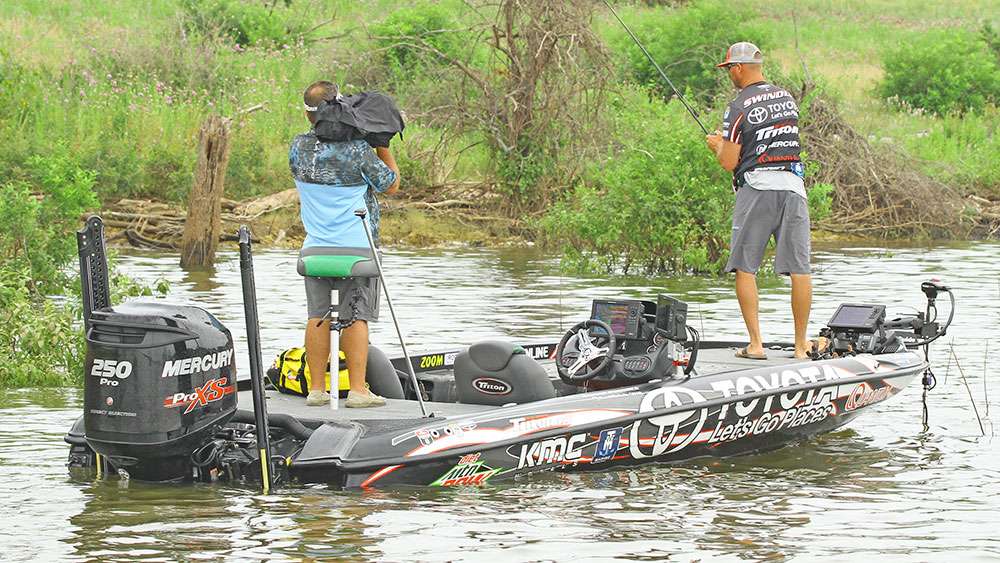
Junk fishing. Just the thought of going fishing without a game plan is a major turnoff.
Junk fishing is a last resort when there is no prevailing pattern in a lake. The junk term comes from the attempt to catch a bass from any casting target or cover encountered along a given stretch of shoreline. You are basically using everything in the tacklebox and casting at anything.
Sometimes finding a fishing strategy to replicate into a pattern is impossible. Weather and environmental factors come into play. That’s what happened at Lake Texoma, site of the GEICO Bassmaster BASSfest presented by Choctaw Resort and Casino.
A great case study in favor of junk fishing developed on Lake Texoma. The water level was 10 feet higher than normal, falling nearly 1 foot each day, and unusually muddy.
There was too much of a good thing. Every flooded bush and tree looked good from end to end of the 1,000 miles of shoreline. As the water receded so did the casting targets.
Patterns eventually fell into place for some anglers, but the top finishers relied on junk fishing.
Count Gerald Swindle among them. He finished third with a total of 60 pounds, 6 ounces, and much of it caught by junk fishing.
Posing a very detailed question about junk fishing produced surprisingly favorable answers from Swindle and Greg Hackney, the BASSfest winner and a junk fishing machine.
Is there such a thing as a pattern in junk fishing?
“Yes, absolutely there is,” said Swindle. “I usually have a little bit of a pattern and that’s true junk fishing.”
That might be several types of casting targets spread out down a long shoreline. Laydowns separated by several hundred yards. In between the wood might be a pile of boulders. Several boat docks along the way.
Those laydowns, boulders and docks all represent parts of a junk fishing pattern to Swindle.
“You still must run the entire bank but you slow down and key on those specific casting targets.”
He emphasized, “A lot of guys just hit the panic button, put the trolling motor on high and just take off down the bank. That’s not junk fishing. That’s just being out of control.”
The most often repeated mistake observed by the guru of junk fishing is fishing too fast.
“When people say they are going junk fishing they start running around wide open and you just can’t do that. You have to slow down when you junk fish.”
Swindle scored success on Texoma with a keen eye for each casting target. He deliberately slowed down to analyze every target.
“You are dialing in to where every fish is staged,” explained Swindle. “Each target is different.”
“You process every one a different way,” he added. “You might be using a different lure for the same piece of wood but at different depths.”
Swindle might put together several pieces of an otherwise unsolvable puzzle as he goes. Either way it’s still junk fishing.
“I’m still going to fish everything on the bank,” he added. “Whatever is in the way might just add to the pieces of a pattern.”
Or sometimes become a true, stand-alone pattern.
Junk fishing has a mentally challenging side, too. Swindle keeps a positive attitude to fight off the demons in his mind telling him to give it up.
“I’ve got a theory and that is fish each cast like it’s the last one of the day,” he said. “If you believe in a bait enough to use it then you’ve got to believe it will produce.”
Hackney responded immediately when asked the question about patterns emerging from junk fishing. He shares Swindle’s belief that patterns, loose and undefined as they might be, exist in junk fishing.
“A lot of times what junk fishing turns out to be is a bunch of little patterns,” he said. “There’s not one dominant pattern but you can get clued in to similarities between productive spots.”
Hackney draws the line between junk fishing and a true pattern by the scope of water required to make it work.
“You still might need a lot of water to make it work,” he added. “And baits, a lot of baits.”
“Every spot might need a different lure and that’s what really defines it as junk fishing.”
Michael Iaconelli provides more proof there’s no shame in junk fishing. The New Jersey pro has won numerous tournaments using the technique. The most recent was a Bassmaster Elite Series event held in 2014 on the Delaware River.
When there are a dozen or more fishing combos laid out ready for action on his front deck then you know Iaconelli is junk fishing.
“I like to think of all those different baits like tools in a toolbox,” he explained. “Every bait, or tool, can fix a specific problem you encounter along a shoreline.”
Those problems, as noted by Iaconelli, are different types of cover where the bass might be.
“I might use those dozen baits in as many types of casting targets,” he explained. “The solutions that I use when junk fishing is keeping an open mind with bait choices.”
And there you have it. Junk fishing is not the crapshoot for which it gets a bad rap. To make it work all you need to do is believe in every stop along the run for its potential to produce a bass.
Or a string of little patterns that can add up to success, as Swindle and Hackney prove time and time again.

